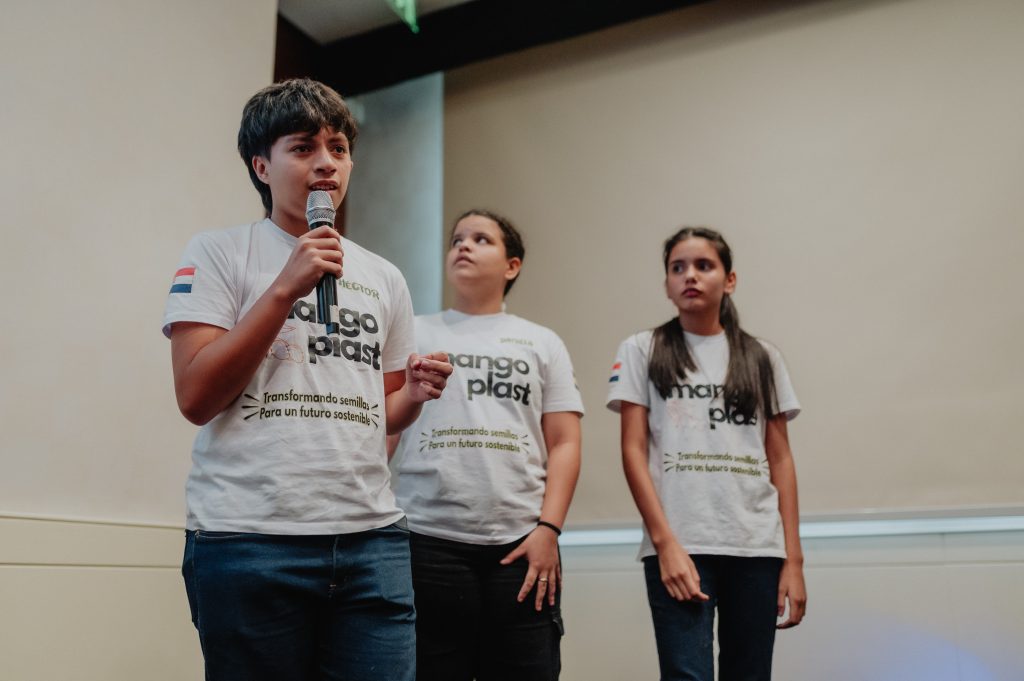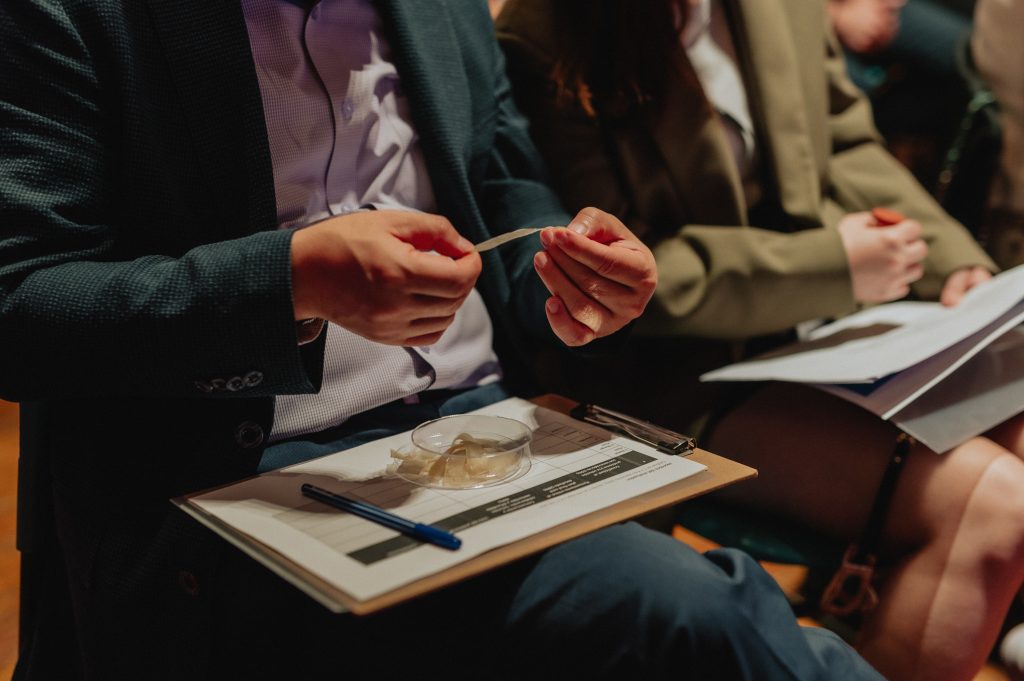The life cycle of plastic is one of the most environmentally damaging processes. According to the United Nations Environment Program (UNEP) in a study from 2023, more than 430 tons of single-use plastic are produced annually, only 9% of which is recycled. The race for biodegradable alternatives is intense, and a group of young students decided to contribute, creating a bioplastic from mango seeds. The aforementioned bioplastic can serve as raw material for making everyday objects such as bags.
The Mangoplast project from Paraguay was one of the finalists in the 2024 edition of the Solve for Tomorrow Program. Mediated by the teacher Adriana Valdez, this initiative was created by students aged between 12 and 13 at the Educational Center Arambé, in the city of Luque. Looking at the abundance of mangoes in the region and the limited usage of mangoes as a public health problem, the group made use of advanced STEM knowledge to create the biodegradable material.
It was a major academic leap for seventh graders (the first year of the third cycle before middle school) who had to learn science concepts that they would only normally come to face in later years.
The mediating teacher recalls that age was a factor of insecurity for the group. “They looked at the other students who were doing projects and said, “They’re older than us, we’re younger. Will we be able to get there, will we be able to achieve results? Look, we are in the top five!”. The teacher’s job wasn’t just to show them that it was possible, but also to point out that other young people from the same school had already succeeded in making bioplastics, and that these could serve as inspiration for them.
This is because the Mangoplast project came out of the experience of the science teacher, who had always taken part in the institution’s science fairs. “Since they were starting off with the subject of science fairs in the third cycle, I pointed out to them that a lot of work had already been done at the school, and among the work that had been done I cited bioplastics. And they were interested. But I had explained to them in class that making plastic from food sources like corn was not such a good idea. My recommendation was to investigate other sources”.
Although they had little experience with scientific research at the outset, the students quickly realized the importance of doing research properly to begin the definition of the project. They split this into two parts: they found out on the internet that mango seeds are a material that can be used to make plastic. The other part of the research entailed getting out of school and taking a look at the environment.
“Mango trees are often a problem here in our country, because almost every house has one. When they start bearing fruit, the mangoes drop onto the streets, which sometimes causes health problems because the flies cluster around the fruit that is on the ground. Mangoes were already going to waste, and the students recognized an opportunity in this and suggested using mango seeds as a raw material”, explains the teacher.

From corn to mango, an adventure full of discoveries
But the fruit bearing season does not coincide with the time line for science. When the students defined the prototype material, the mangoes were no longer so easy to find. The first challenge was to make a quick pick of the mangoes that remained. They collected the fruit that had fallen in the streets, took them to the school’s labs and cut up the fruit together.
Inside the mango seeds there is the cotyledon, which is the most tender part, the last vestige of the embryonic process. This material was crushed with water. In order to extract the starch, which is the organic matter crucial for producing plastic, the students based their approach on a technique that was widely used by the grandmothers of the field, which involves filtering the water with linen. It is necessary to repeat the process many times, until the starch reaches the desired consistency.
The students already had the basis for the project on account of the previous project that used corn for plastic, but they very quickly discovered that it would be different with mangoes. “They tried to use the same proportions of water, starch, vinegar and glycerin, but the resulting consistency was very different to the one they obtained with corn flour. They had to try out various different proportions of the starch to produce the most suitable film”, adds Valdez.
Glycerin acts as a plasticizer while vinegar helps break down starch chains and stabilize the film. Students put the mold drying films on the school stove for two or three days, until the sheets are ready. After a great deal of testing, the group discovered the ideal ingredient mixture to make the sheets: 20 grams of mango seed starch; 200 or 150 ml of water; 15 g of glycerin and 15 g of vinegar. Roughly 10g to 15g of bioplastic is required to produce a 30×30 cm bioplastic bag, which was the group’s final objective. Between three and seven mango seeds are needed, depending on the size of the fruit.

The challenges of scientific research
The first challenge for the students was to make plastic sheets that would not break and that were flexible. The first tests produced plastic sheets that were decidedly fragile. It took a lot of patience and a great many trial runs to reach the understanding that there was no way to dry the plastic in natural conditions, using sunlight and wind. The stove, as well as the school laboratory, was very important for calibrating the correct amount of time.
Conventional plastic has a transparent appearance, which can be dyed in a variety of ways. Another challenge was getting the correct color, because the first few tests resulted in a dark brown foil. The secret lay in the starch extraction process, as the teacher recalls: “I told the students “Let’s try to get that water out and wash it again”. And we did just that, we took the brown colored water from above the dust, we washed the plastic sheet again and it became clearer and when dried it already became a lighter powder”.
But the main challenge was actually time itself : the whole manual process was a very labor-intensive one , and the group of students only had three months to produce the plastic, achieve the correct color and make the bag manually. By the end of the quarter, the group had managed to manufacture the plastic sheets. But since the students will be remaining at school , they are full of enthusiasm regarding the next steps in the manufacturing process.
The next steps for bioplastics
Since the school has already included the collective use of spaces for STEM projects into its regular practices, the laboratories and stove were valuable resources for the young students. The science fair culture, something new for third cycle students, played a decisive role in developing the different stages of the prototype. To make a beautiful confection of bags, the idea now is to look for some sort of partnership outside of school. The group is already in contact with one of the country’s largest plastic manufacturers, which has invited the students to visit the factory in order to understand how objects are made.
For the teacher, it was a privilege to be able to watch the students grow as they proceeded along their learning path. Since they were younger than most of the other students who were participating in the projects that were the finalists of the Solve for Tomorrow program, their transformation was different , and was one that prepared them for the next stages of teaching and life: “When I first saw them they were very small and quiet, and I tried to give them some encouragement. The program really helped them grow, to learn how to convey their ideas and to speak in front of an audience. Despite the fact that they are very young they were able to do it. I am very proud of my students because they grew up so quickly. It really was a major growth and learning experience as well”.




